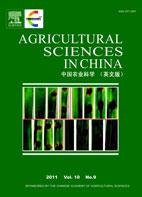|
|
Raising on Water Stocking Density Reduces Geese ReproductivePerformances via Water Bacteria and Lipopolysaccharide Contaminationsin “Geese-Fish” Production System
JIANGDan-li , LIULi , WANG Cong-li, CHEN Fang, SUN Ai-dong , SHI Zhen-dan
2011, 10(9):
1459-1466.
DOI: 10.1016/S1671-2927(11)60139-9
This study was carried out to unravel the mechanism of reductions in production performances in high stocking densitygeese flocks during summer months in “geese-fish” production system. Experiment 1 observed the water bacterialgrowth, lipopolysaccharde concentrations in water and geese blood, and geese reproductive performances from summerto winter, in two flocks with varying on water stocking densities. Results showed that counts of total bacteria, Escherichiacoli and Salmonella in water, as well as water and geese plasma LPS concentrations, exhibited a tendency decreasing fromthe highest levels in summer, to intermediate levels in autumn, and to the lowest values in winter. Such seasonaldecreases in bacteria and LPS concentrations were associated with similar seasonal decreases in embryo mortality duringincubation. In addition, embryos dead or showing development retardation by day 25 of incubation contained copiousLPS in allantoic fluid, in contrast to the negligible amount in normal developing embryos. Raising on water stockingdensity elevated bacteria counts, LPS concentrations in water and geese plasma, and decreased egg fertility but increasedembryo mortality during incubation. In experiment 2, exogenous LPS treatment to the geese depressed egg laying,reduced egg hatchability, caused sickness behavior in the goslings hatched. In experiment 3, exogenous LPS directlyadministered to day 8 and 18 embryos during incubation dose dependently increased mortality and decreased hatchability,and caused sickness behavior in the goslings hatched. It is concluded that the raising on water geese stocking densitystimulates pathogenic bacteria growth in water, which via LPS contamination impaires embryo development in incubationand therefore reduces geese reproductive performance and gosling quality during the hot summer months.
|
